-
×
 Bo mạch BBC micro:bit V2
1 × 550.000 ₫
Bo mạch BBC micro:bit V2
1 × 550.000 ₫
Tổng số phụ: 550.000 ₫
Bạn có từng mê mẩn với trò chơi Tetris huyền thoại? Trong dự án này, chúng ta sẽ lập trình một phiên bản đơn giản của Tetris ngay trên màn hình LED 5×5 của Micro:bit! Bạn sẽ học cách sử dụng vòng lặp, điều kiện, mảng và nút bấm để điều khiển khối rơi xuống. Một dự án vừa học vừa chơi rất lý tưởng cho học sinh, sinh viên và người yêu thích lập trình!
Ngoài ra, bạn cần thêm máy tính có trình duyệt truy cập https://python.microbit.org/v/3 để thực hiện code và nạp code cho Micro:bit
Sẽ có 4 khối được thiết kế như hình dưới:

Khối (block) sáng sẽ rơi từ trên xuống màn hình LED.
Người chơi dùng nút A để di chuyển trái, nút B để di chuyển phải và ấn cả hai nút để xoay khối.
Nếu khối chạm đáy hoặc khối khác, nó sẽ đứng yên.
Nếu xếp đầy một hàng, hàng đó sẽ biến mất và bạn được 10 điểm.
Trò chơi kết thúc khi các khối chạm đỉnh màn hình.
from microbit import *
from random import choice
#Set up the tetris grid
grid=[[1,0,0,0,0,0,1],[1,0,0,0,0,0,1],[1,0,0,0,0,0,1],[1,0,0,0,0,0,1],[1,0,0,0,0,0,1],[1,1,1,1,1,1,1]]
#Store a list of 4 bricks, each brick is a 2x2 grid
bricks = [[9,9],[9,0]],[[9,9],[0,9]],[[9,9],[9,9]],[[9,9],[0,0]]
#select a brick randomly and position it at the center/top of the grid (y=0,x=3)
brick = choice(bricks)
x=3
y=0
frameCount=0
#A function to return the maximum of two values
def max(a,b):
if a>=b:
return a
else:
return b
#A function to hide the 2x2 brick on the LED screen
def hideBrick():
if x>0:
display.set_pixel(x-1,y,grid[y][x])
if x<5:
display.set_pixel(x+1-1,y,grid[y][x+1])
if x>0 and y<4:
display.set_pixel(x-1,y+1,grid[y+1][x])
if x<5 and y<4:
display.set_pixel(x+1-1,y+1,grid[y+1][x+1])
#A function to show the 2x2 brick on the LED screen
def showBrick():
if x>0:
display.set_pixel(x-1,y,max(brick[0][0],grid[y][x]))
if x<5:
display.set_pixel(x+1-1,y,max(brick[0][1],grid[y][x+1]))
if x>0 and y<4:
display.set_pixel(x-1,y+1,max(brick[1][0],grid[y+1][x]))
if x<5 and y<4:
display.set_pixel(x+1-1,y+1,max(brick[1][1],grid[y+1][x+1]))
#A function to rotate the 2x2 brick
def rotateBrick():
pixel00 = brick[0][0]
pixel01 = brick[0][1]
pixel10 = brick[1][0]
pixel11 = brick[1][1]
#Check if the rotation is possible
if not ((grid[y][x]>0 and pixel00>0) or (grid[y+1][x]>0 and pixel10>0) or (grid[y][x+1]>0 and pixel01>0) or (grid[y+1][x+1]>0 and pixel11>0)):
hideBrick()
brick[0][0] = pixel10
brick[1][0] = pixel11
brick[1][1] = pixel01
brick[0][1] = pixel00
showBrick()
#A function to move/translate the brick
def moveBrick(delta_x,delta_y):
global x,y
move=False
#Check if the move if possible: no collision with other blocks or borders of the grid
if delta_x==-1 and x>0:
if not ((grid[y][x-1]>0 and brick[0][0]>0) or (grid[y][x+1-1]>0 and brick[0][1]>0) or (grid[y+1][x-1]>0 and brick[1][0]>0) or (grid[y+1][x+1-1]>0 and brick[1][1]>0)):
move=True
elif delta_x==1 and x<5:
if not ((grid[y][x+1]>0 and brick[0][0]>0) or (grid[y][x+1+1]>0 and brick[0][1]>0) or (grid[y+1][x+1]>0 and brick[1][0]>0) or (grid[y+1][x+1+1]>0 and brick[1][1]>0)):
move=True
elif delta_y==1 and y<4:
if not ((grid[y+1][x]>0 and brick[0][0]>0) or (grid[y+1][x+1]>0 and brick[0][1]>0) or (grid[y+1+1][x]>0 and brick[1][0]>0) or (grid[y+1+1][x+1]>0 and brick[1][1]>0)):
move=True
#If the move is possible, update x,y coordinates of the brick
if move:
hideBrick()
x+=delta_x
y+=delta_y
showBrick()
#Return True or False to confirm if the move took place
return move
#A function to check for and remove completed lines
def checkLines():
global score
removeLine=False
#check each line one at a time
for i in range(0, 5):
#If 5 blocks are filled in (9) then a line is complete (9*5=45)
if (grid[i][1]+grid[i][2]+grid[i][3]+grid[i][4]+grid[i][5])==45:
removeLine = True
#Increment the score (10 pts per line)
score+=10
#Remove the line and make all lines above fall by 1:
for j in range(i,0,-1):
grid[j] = grid[j-1]
grid[0]=[1,0,0,0,0,0,1]
if removeLine:
#Refresh the LED screen
for i in range(0, 5):
for j in range(0, 5):
display.set_pixel(i,j,grid[j][i+1])
return removeLine
gameOn=True
score=0
showBrick()
#Main Program Loop - iterates every 50ms
while gameOn:
sleep(50)
frameCount+=1
#Capture user inputs
if button_a.is_pressed() and button_b.is_pressed():
rotateBrick()
elif button_a.is_pressed():
moveBrick(-1,0)
elif button_b.is_pressed():
moveBrick(1,0)
#Every 15 frames try to move the brick down
if frameCount==15 and moveBrick(0,1) == False:
frameCount=0
#The move was not possible, the brick stays in position
grid[y][x]=max(brick[0][0],grid[y][x])
grid[y][x+1]=max(brick[0][1],grid[y][x+1])
grid[y+1][x]=max(brick[1][0],grid[y+1][x])
grid[y+1][x+1]=max(brick[1][1],grid[y+1][x+1])
if checkLines()==False and y==0:
#The brick has reached the top of the grid - Game Over
gameOn=False
else:
#select a new brick randomly
x=3
y=0
brick = choice(bricks)
showBrick()
if frameCount==15:
frameCount=0
#End of Game
sleep(2000)
display.scroll("Game Over: Score: " + str(score))
Thêm nhiều loại khối.
Kết nối 2 người chơi bằng radio để gửi điểm.
Thêm âm thanh khi ghi điểm hoặc game over.